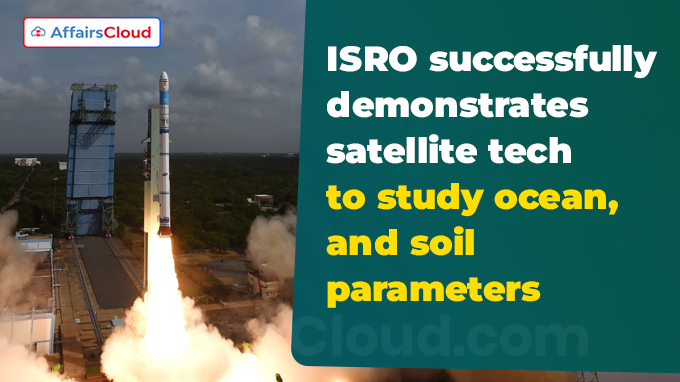 The Indian Space Research Organisation (ISRO) has successfully demonstrated a technique to collect data on soil moisture, surface inundation, and ocean surface wind and wave measurements, by using satellite based sensor Global Navigation Satellite System Reflectometry(GNSS-R) that is 475 kilometer (km) above the earth.
The Indian Space Research Organisation (ISRO) has successfully demonstrated a technique to collect data on soil moisture, surface inundation, and ocean surface wind and wave measurements, by using satellite based sensor Global Navigation Satellite System Reflectometry(GNSS-R) that is 475 kilometer (km) above the earth.
- GNSS-R, developed by the ISRO’s Space Applications Centre (SAC-ISRO), is India’s 1st space-borne precision receiver.
- GNSS-R is a new method of remote sensing, which helps in collecting information about objects or places from a distance by using aircraft, satellites, or drones equipped with sensors and detecting the energy that is reflected from the Earth.
Background:
i.On 16th August 2024, ISRO had successfully launched the Earth Observation Satellite i.e. EOS-08, on board the 3rd developmental flight of Small Satellite Launch Vehicle (SSLV-D3).
ii.GNSS-R was, mounted on EOS-08 satellite, commenced operations on 18th August, 2024.
Key Points:
i.The raw data collected by the GNSS-R instrument is being processed at the ISRO’S National Remote Sensing Centre (NRSC) based in Shadnagar(near Hyderabad), Telangana.
ii.The data is being processed by using algorithms and data processing software developed by Ahmedabad(Gujarat)-based SAC-ISRO.
iii.Global and Regional Navigation Satellite Systems (GNSS/RNSS) Signals, such as Global Positioning System (GPS) and NavIC(Navigation with Indian Constellation), are reflected off various earth surfaces such as: oceans, agricultural lands and river bodies.
iv.These reflected signals are captured by a precision receiver onboard the satellite as it orbits the Earth at the height of 475 km.
- It is operated without dedicated transmitters and is shallow in resource consumption like requires minimal size, weight, and power.
- Also, it can increase as a constellation of receivers for faster coverage.
About GNSS-R:
i.The main function of GNSS-R is to collect ground-reflected GNSS Signals and measures their power and other signal characteristics.
- These measurements can be processed to derive scientific information about regions covered by the receiver including, soil moisture, surface inundation and ocean surface wind and wave measurements.
ii.It provides a resolution of 15 km×15 km over oceans and better than 1 km ×1 km over land.
iii.The primary outputs from GNSS-R raw data processing are: Delay-Doppler Maps (DDMs), which are used to derive parameters like: reflectivity and Normalized Bistatic Radar Cross-Section (NBRCS).
- These NBRCS are further used for the retrieval of different scientific parameters.
Note: As perISRO, all the science products are produced at SAC-ISRO using in-house developed algorithms.
Key Observations:
i.The GNSS-R instrument collected 1st land data over the Sahara Desert (North Africa) using s high resolution mode of 1 km, which is way better than that of contemporary Cyclone Global Navigation Satellite System (CYGNSS) sensors.
- This data was processed to capture soil moisture at high resolution.
ii.On 21st August 2024, another high resolution land dataset was captured over the Amazon rainforest. This data set has been used to surface inundation masks along the specular reflection track which shows sensitivity even towards sub-kilometer river widths.
iii.On 19th August 2024, the 1st ocean data was collected over the Pacific ocean region. This data set was processed for the retrieval of wind speed and wave height.
About Indian Space Research Organisation(ISRO):
Chairman- Sreedhara Panicker Somanath
Headquarters– Bengaluru, Karnataka
Established– 1969




